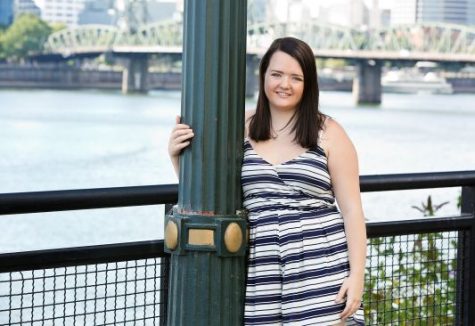I.B. Art fosters talented artists to make masterpieces
December 7, 2015
The HL I.B. art class at Cleveland is small but overflowing with talent. Recently, the nine students finished a project they had been working on for about three weeks. Numerous pieces are now on display in the east wing outside of Terry Waldron’s classroom, room 286. The artwork ranges in medium, including embroidery, painting, resin, photography, markers, and paper cutting. Three senior students discussed the symbolism behind their pieces, their process, and how they incorporate art into their lives.
Clancy O’Connor
O’Connor’s theme for the year is about people in their environments, a broad theme that allows him to have freedom and explore different options.
He created two pieces on display, one that depicts chicken legs towering over a driving car and the other that abstractly portrays painting of buildings. O’Connor explained that he altered his coloring technique for both pieces by using blue and purple as shadows and opting to not outline anything. “I tried to focus on using perspective and having an implied line rather than a directly visible outline.”
O’Connor is constantly brainstorming ideas and sketching in his notebook. “I’m doodling in my sketchbook and drawing all the time,” he said. “For a finished piece my inspiration will usually stem from various elements in my sketchbook.”
Experience and interest are main contributors to O’Connor’s talent. “People think there is a lot of natural talent in art, but I have a different philosophy. I don’t think that anyone who is a good artist really has natural talent; I think they just really like to do it and they do it a lot,” he explained.
O’Connor plans to continue art in college and is currently applying to the Product and Design program at University of Oregon to “apply [my art] in a more utilitarian way.”
“Creating something tangible with my hands is such a good feeling and I love doing it. I definitely want to continue pursuing art in the future,” he said.
Shelby Wong
Wong expressed her theme about being Chinese-American in two different mediums: painting and embroidery. For the painting, she juxtaposed her Chinese-American identity (seen in the inside circle) with an American identity (painted outside of the circle). Wong gained inspiration from the items in her room and desk to represent Chinese-American culture.
She described the process as “long and painful” since she had to layer watercolor paint multiple times on the wood fiberboard.
Wong’s second artwork, an embroidery piece, depicts a girl curled up inside a Chinese take out box. The simple yet powerful artwork has personal meaning for Wong and her culture. In the embroidery, she symbolized a problem with many people’s attitudes surrounding Chinese-American food.
“I feel like a lot of American people take for granted all the effort that’s put into Chinese-American food because it’s something that’s always been very accessible,” Wong said. “We’ve come to a point, especially in Portland, where getting authentic food is considered more of the ‘hip’ thing, but many people ignore some of the Chinese-American culture that exists within it.” Wong is especially connected to this issue because her family used to own a restaurant.
Wong says embroidery wasn’t taught in the classroom. Rather, she studied it independently and then utilized her skill for the class project.
Penny Stricklin
Stricklin’s theme is on the emotion of science, and she investigates the similarities and differences of how we interact with science. One piece she made shows an intricate human body cut from different colored paper. “I included two modes of emotion: passion, which is represented in red, and coolness or detachment, which is represented in blue. It also evokes the cardiovascular system, since we have red and blue blood.”
She termed her medium “tri-layer paper cutting,” where she glued pieces of paper on top of each other and cut out parts of the paper where she wanted the hidden layer to show. Stricklin’s three colors (from back to top) are red, blue, and black.
“This is one of my favorite mediums. I tend to draw it out and then I’ll use a really sharp X-Acto knife and just go at it,” Stricklin said. Stricklin is able to speed through the cutting relatively quickly, but she has to be very precise to prevent mistakes. “Sometimes I have to do more than one draft because I’ll accidentally cut off an entire arm.”
Stricklin started art freshman year because she wanted to pursue architecture. Now, she has changed her interests in profession but still likes art as it allows her to express herself. “Art is a way to say something that everybody can understand,” Stricklin said.












